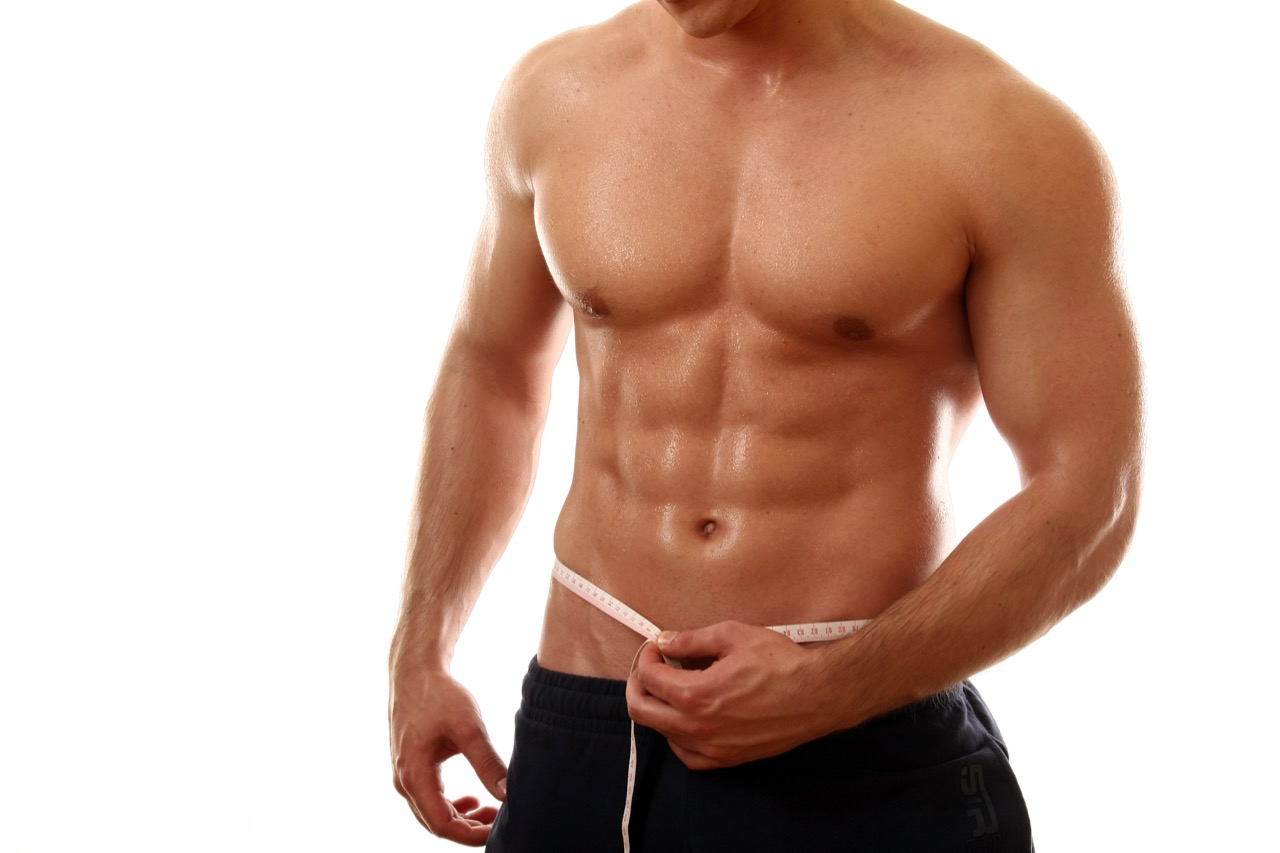Weight vs Body Composition
Most people are way too fixated on their weight and what the numbers tell them on scales. If all you want to do is lose weight then starving yourself and going mad on cardio workouts until you burn out will probably achieve this for you. The trouble is you are likely to end up ‘skinny fat‘ – having too high % body fat and too little muscle. Even if you are ‘normal weight’ it is possible to be skinny fat.
If you are looking to build a better body and physique (for health and looks!) then you need to develop muscle definition and this requires changing your body composition.
Losing weight is not actually the hard part – changing the body composition is. The problem is that the process of cutting back on calories in order to speed up fat loss will also result in muscle loss as well – not what you want for health or better physique or improved muscle definition.
Remember you cannot exercise yourself out of a bad diet if you want to lose weight as a recent review paper highlighted. For optimal health we need a programme that focuses on building muscle and losing fat at the same time.
While that might sound simple, in practice it is not always easy. Typically people cut back too hard on calories (and do a ton of cardio) which in turn makes it hard to build muscle. To make matters worse as we age we naturally lose muscle making it more important to focus on building not losing muscle mass.

The Process of Building Muscle
Whether you are a woman or a man, if you want to build muscle your body must create more muscle proteins than it loses. This requires energy (i.e. calories) and effort – you have to promote more muscle synthesis than protein (muscle) degradation. Running for miles is not the answer. While cardio like running with improve oxygenation and VO2 max it may not necessarily change muscle mass.
Resistance or strength training is more effective. This is because it recruits type 2 muscle fibres which are more involved in muscle gain. Strength training damages muscle cells, which then stimulates protein synthesis rates to repair the tissues. Not only that but with the right training you can add new muscle cells, increasing the muscles’ size and strength. The good news is that you can maintain or even improve muscle mass when in a slight calorie deficit.
Strength training particularly lifting heavier and heavier weights as you progress also triggers the short-term production of hormones such as human growth hormone and testosterone that aid in muscle retention and building. Gradually putting your muscles under more stress lifting heavier loads, your muscles can adapt to get bigger and stronger.

Don’t Drastically Cut Calories
Cutting back too much on your calorie intake will result in both fat and muscle loss. Building muscle as body builders will know typically requires them to be in an energy surplus not a deficit. So in addition to undertaking the right training you also need to get your calorie intake and macro nutrients right. Remember your goal is to lose fat not muscle so if you are restricting calories too much you will end up losing muscle. This is more likely if you skimp on your protein intake. Studies have shown a higher protein diet is more effective at reducing body fat while preserving muscle. It also helps keep you feeling fuller for longer making it easier to stick to the plan.
But how much protein do you really need? Well the government guidelines are 0.8g per kg of body weight. The trouble is that this doesn’t tie in with the latest research. Many studies show that you need double or even more this to preserve muscle while losing fat.
In fact one review the researchers stated
‘Protein needs for energy-restricted resistance-trained athletes are likely 2.3-3.1g/kg of FFM scaled upwards with severity of caloric restriction and leanness’.
That is a lot more protein than the government guidelines! As this review focused on trained athletes, depending on your amount of training you are undertaking, you may not actually need this amount. Instead you may wish to start at around 1.2-1.6g per kg of body weight.
How Many Calories Do you Actually Need?
But what about the calories? Yes calories do matter when it comes to energy balance and weight loss. Gradual reduction in calories is generally more effective than extreme restriction (there are exceptions – e.g fasting mimicking diet can be an effective strategy for 5 days). If you want to lose weight and body fat you will however need to be in a calorie deficit but you don’t want to drastically cut back so that you experience muscle loss.
For this reason I suggest sticking to a 20-25% calorie deficit which will allow you to lose fat while preserving muscle but you have to make sure you get sufficient protein. To work out how many calories you need you can use one of the calorie counters such as My Fitness Pal or Lose It! Remember these are estimates and include an activity factor based on what you tell the calculator your activity levels are. It also depends on your current % body fat and muscle mass. Another quick way to estimate your Total Daily Energy Expenditure (TDEE) is to multiply your weight in lbs by 14-16 depending on how active you are. If you are training hard in the gym five times in the week for example then multiply by 16.
Once you know what calories you are burning simply multiply by 0.75 to get the calories you should be aiming for to put your body under calorie deficit. In general a female should reduce calories by about 300 to 400 calories and males about 400 to 600 calories. Remember within this calorie allowance you need to ensure you get your protein needs.

You Have to Train
You won’t see significant improvements to your muscle mass if you are not training. Aim for 4-6 sessions of resistance training with the aim of adding more load as you progress. Most people find it better to split their schedule into upper-body days and lower-body days.
Do HIIT Training
While resistance training will give you results, to improve fat burning add in a couple of High Intensity Interval Training sessions (HIIT) over the week – this could be on a treadmill or stationary bike. Unlike steady-state cardio, high intensity training also recruits type-2 muscle fibres helping to get more noticeable improvements. HIIT training is particularly useful if you have reach a plateau in your weight loss.

Focus on Recovery and Sleep
Recovery and quality sleep is essential for improving muscle mass. If you fail to get enough sleep this can cause havoc to hormone levels, growth hormone and blood sugar levels which all play a role in maintaining and building lean muscle. Cortisol increases in times of sleep deprivation which is catabolic meaning it will inhibit weight loss and promote muscle degradation. Meanwhile, human growth hormone—which supports muscle growth and repair is at its highest during sleep.
One study showed that as little as four days of sleep deprivation reduces the body’s insulin sensitivity, increasing the risk for fat storage, while reducing the body’s levels of growth hormone.

Track your Progress
I am a big fan of tracking progess when it comes to gym workouts and diet. While some people notice their changes visibly it can be deceptive. When you are looking to transform certain parts of your body with a proper workout programme and diet plan marked changes may not be so obvious. That can lead you to feeling all your efforts are a waste of time and then the diet slips and you start to skip those workouts.
To make sure that both your workout programme and diet plan is right for your goals taking certain measurements each week is recommended. I am not a big fan of stepping on the scales each day because weight can fluctuate (water retention, menstrual cycle etc). So I generally suggest you weigh yourself each week.
To do this weigh yourself first thing in the morning naked. Write it down and keep a record of weekly changes.
Secondly you need some ideal of your body composition changes. Gyms are a useful place to get your muscle mass and body fat measured and certain weighing scales at home will do this but again these can flucuate depending on your hydration status. A simpler approach is to take a measurement of your waist circumferance. With your stomach relaxed (do not suck in your tummy!), circle your waist with a measuring tape, just above your belly button and pull it tight but not so tight it dents your skin. Take this measurement each week.
Finally I suggest you take photos of your body. This is a great visual way to assess your longer term changes. Like weighing scales I suggest you take the pictures the same time each week, ideally in the morning (before breakfast) in the same underwear or gym clothes. Take photos from the front, back, and both sides.
A combination of weighing scales, waist measurements and pictures will help track your progress and keep you focused on your end goal. It also will allow you to modify your workouts and diet plan as needed.

